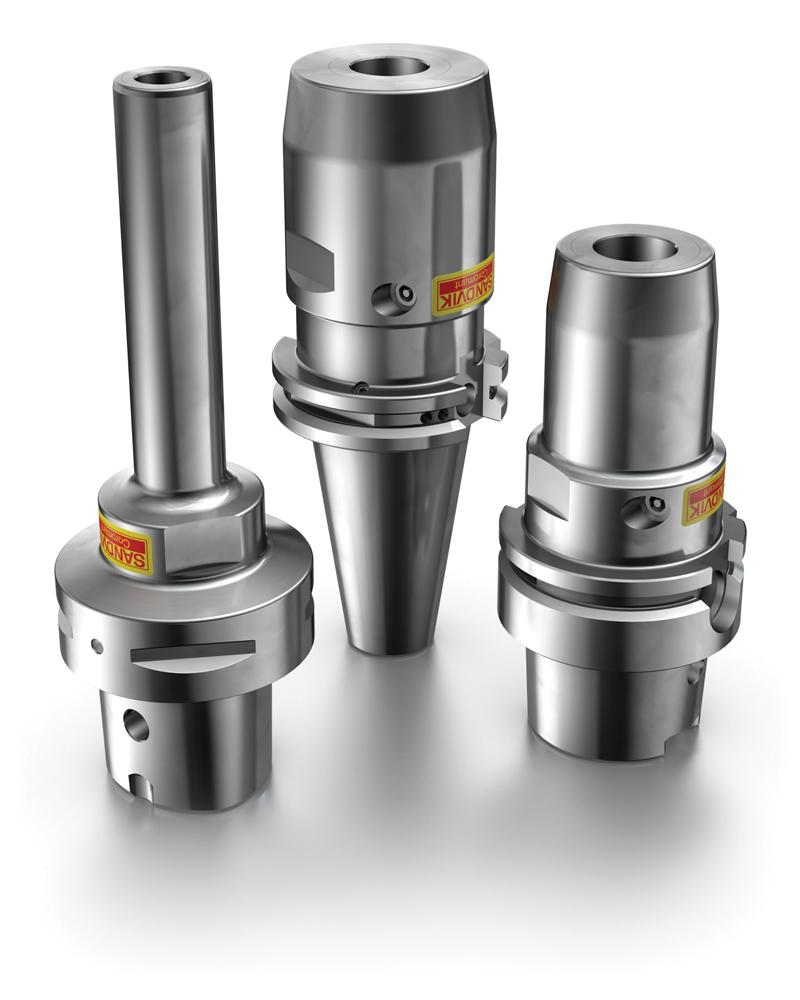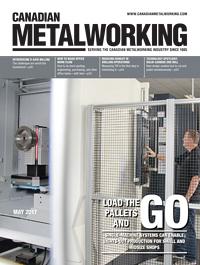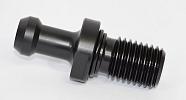- FMA
- The Fabricator
- FABTECH
- Canadian Metalworking
Reducing Runout in Drilling Operations
Measuring TIR is the first step in minimizing it
- By Nate Hendley
- May 3, 2017
- Article
- Cutting Tools

Hydraulic toolholding, such as the CoroChuck, dampen vibrations in the drilling process and help reduce runout. Photo courtesy of Sandvik Coromant Canada.
Runout is all too commonly overlooked in drilling operations.
Runout occurs in a rotating mechanical system when the shaft or tool isn’t rotating precisely in line with the main axis. In a drilling scenario, runout can lead to a hole bigger than the nominal diameter of the drill because the drill is being rotated off-axis rather than in line.
The level of runout, or total indicated runout (TIR) to use the technical term, can be measured with a dial indicator.
“When someone calls me on the phone to troubleshoot something, the first thing I tell them to do is check the runout in a mill. In a lathe, it’s check the alignment,” explained David Vetrecin, holemaking product manager for Iscar Canada. “These are the first go-to solutions. Runout is overlooked 90 per cent of the time.”
So why is runout ignored?
“No one seems to realize how important it is,” said Vetrecin.
Ignoring runout when drilling is a recipe for disaster because all drilling parameters will suffer.
“Minimizing tool runout and alignment is one of the most important criteria for successful holemaking because they affect process security, tool life, component quality, and surface finish,” said Randy McEachern, product specialist at Sandvik Coromant Canada. “Often we see uneven margin wear. In addition, the hole will be oversized and the finish can be coarse. In some cases, there will be a retraction swirl line in the hole.”
A severe runout condition often leads to tool breakage in solid-carbide drills.
“Runout and tool life are always inversely correlated and on an exponential scale. As runout increases, tool life and productivity will be reduced drastically,” said Cullen Morrison, business development manager at Komet of America.

Runout-adjustabe holders, like this DAH50HS enable adjustments to be made without affecting the clamping of the tool. Photo courtesy of Komet of America.
Fortunately, drilling runout can be reduced, and even eliminated (in theory, at least).
Eliminating Runout
“For a period of time when things are new, it may be possible [to eliminate runout], but you are always shooting for as close to 0.0 as possible. Once things start to wear, you have no chance unless you are using a runout adjustable holder,” said Morrison.
Given this situation, it’s more practical to try to minimize runout when drilling than to completely eliminate it, which means tolerating a degree of runout. Determining an acceptable level of runout when drilling depends on the drill being used, as well as other factors.
A TIR of 0.0002 in. or less is acceptable for most solid-carbide drill applications. Exchangeable-tip drills have a similar self-centring capability combined with a flexible steel body, therefore it’s important to have less than 0.001-in. TIR.
Indexable insert drills are not expected to work within the same tolerance range so runout is not as critical.
“In lathe applications, turret alignment also becomes a factor. With solid-carbide drills we recommend that the drill centrepoint be no more than 0.0008 in. off centre to reduce breakage. Indexable drills should be no more than 0.0012 in. off centre for good performance,” said McEachern.
For Morrison, acceptable runout depends on the end result you are trying to achieve, with what tool, and if that is the last tool in the process.
“A small-diameter or long-length, solid-carbide tool will likely chip or break with runout over 0.0005 in., but a large-diameter, steel-bodied indexable drill will have no problems, and may even be able to be offset intentionally up to 0.020 in. to have better control over the hole,” said Morrison. “Then you could also look at this if the drill will later be followed by a precision tool like a high-performance reamer. Runout of the drill, especially if it is inconsistent, will affect the remaining stock for the reamer and potentially the hole roundness condition. This will greatly affect the reamer performance. Same for a tap or any other follow-up tool.”
Hold Tight During Drilling
To keep drilling runout within reasonable bounds, toolholder selection is key.
Multiple styles of toolholders are available for drilling. Some apply either equal pressure around the periphery or a single line of contact in the bore with screws. Options include shrink-fit, hydraulic, collet chucks, drill adapter, and Weldon holders. Depending on the type of drill, one type of holder typically is better than another.

New drilling technology, such as the HCP-IQ SumoCham, use exchangeable-head drills to reach depths of 12xD without the need for a pilot hole. Photo courtesy of Iscar Canada.
“For optimum stability and minimal runout, clamping solid-carbide drills in shrink-fit [toolholders] is best, although there is a larger investment with the heating system,” said McEachern. “Hydraulic chucks can provide less than 4 µm or 157 microinch at 2.5 times the length-to-diameter ratio, are easier to handle, and more economical.”
ER or other flexible collet systems also can be used.
Small indexable drills are best run in collet chucks, added McEachern, but drill adapters and Weldon holders also are acceptable.
“As the drill diameter gets larger, drill adapters are the first choice. These types of holders also provide a high degree of torque transfer for indexable drills. Runout has little influence in this case. It does not make sense to purchase a hydraulic holder for an indexable drill,” said McEachern.
Vetrecin is also fond of hydraulic chucks. He said a hydraulic chuck or a milling chuck would be his first pick for a solid-carbide or exchangeable-tip drill, but, again, not for an indexable drill.
“The hydraulic chuck has a bladder inside and it actually dampens the vibration in the drill if there is any. It has a dampening effect on drilling,” said Vetrecin.
Material Doesn’t Matter
The size of the hole being drilled has an impact on runout considerably more than the material being cut or the cutting parameters.
“Material has no effect on tool runout. That is all a mechanical relationship between the axis position of the tool and rotation of the spindle. But some materials may cause a tool to fail faster from extreme runout than others,” said Morrison.
There also is no relationship between the cutting parameters and runout.
“However, at high RPMs, some tools can bend and start to whip, which will change the rotation axis of the centre of the tool,” said Morrison. “Cases like this in deep-hole drilling, for example, highlight why it is important to drill a high-precision pilot hole with a separate, shorter tool and then enter that hole with the deep-hole drill at a slow RPM. Then the tool cannot whip excessively.”
Hole size and condition should be monitored because they can be an indicator of the alignment of the tool.
“Where small drills are most problematic is in lathe applications, where we often see misalignment in the turret. This frequently causes breakage,” said McEachern.
“Smaller holes are more problematic only because of percentages. A 0.0007-in. runout on a 0.050-in. hole is a much larger problem than the same runout on a 0.750-in. hole,” added Morrison.
Deep-hole drilling operations present special challenges for anyone looking to reduce runout.
“Always use a high-quality hydraulic chuck for good balancing and drill a pilot hole with a short drill first. Also, use high-pressure coolant with a strong concentration,” said McEachern.
According to McEachern, there are a few good tips to reduce runout in general drilling operations: “Invest in new equipment when possible, and keep existing equipment maintained and in good condition.”
Morrison agrees.
“Buy good-quality components, measure the runout at the tool base and the tip of the tool. Use a runout-adjustable holder, if necessary. Follow the manufacturer’s recommendation for usage, and keep toolholders clean and assemble them properly,” he said.
Of course, it all comes back to just being aware of runout in the first place.
“It doesn’t matter what drill you’re using; you want to keep runout minimal. It doesn’t matter if you have a head that’s designed for straight holes or self-centring. If the runout is there, the drill is going to wander. That’s the first thing: Always look at runout,” said Vetrecin.
Contributing writer Nate Hendley can be reached at nhendley@sympatico.ca.Iscar Canada, 905-829-9000, www.iscar.ca
Komet of America, 847-923-8400, www.komet.com
Sandvik Coromant Canada, 905-826-8900, www.sandvik.coromant.com
About the Author
subscribe now


Keep up to date with the latest news, events, and technology for all things metal from our pair of monthly magazines written specifically for Canadian manufacturers!
Start Your Free Subscription- Industry Events
MME Saskatoon
- May 28, 2024
- Saskatoon, SK Canada
CME's Health & Safety Symposium for Manufacturers
- May 29, 2024
- Mississauga, ON Canada
DiPaolo Machine Tools Open House 2024
- June 4 - 5, 2024
- Mississauga, ON Canada
FABTECH Canada
- June 11 - 13, 2024
- Toronto, ON Canada
Zoller Open House & Technology Days 2024
- June 12 - 13, 2024
- Ann Arbor, MI




















